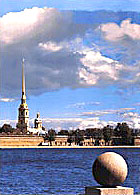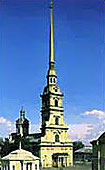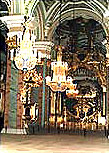The Peter and Paul Fortress
 Designed to protect newly acquired lands from invading Swedes (it worked - the Swedes were kept at bay for almost three centuries and only now are able to realize their historic imperial ambitions through trendy restaurants, luxury hotels, and catering companies), the hexagonal shaped Peter and Paul Fortress lost its military significance before it was completed.
Its guns never saw any action and were put to use as a flood warning signal and the fortress housed a political prison for two hundred years.
Designed to protect newly acquired lands from invading Swedes (it worked - the Swedes were kept at bay for almost three centuries and only now are able to realize their historic imperial ambitions through trendy restaurants, luxury hotels, and catering companies), the hexagonal shaped Peter and Paul Fortress lost its military significance before it was completed.
Its guns never saw any action and were put to use as a flood warning signal and the fortress housed a political prison for two hundred years.
One of its first prisoners was Alexis (Peter the Great's own son), accused of subversion and treason and subsequently tortured to death under Peter's supervision.
Other famous prisoners interned here were the Decembrists (five hanged, over one hundred packed off to Siberia), Dostoevsky (subjected to a mock execution and exiled to Siberia), Lenin's brother (hanged) and the writer of revolutionary leaflets, Maxim Gorky (vilified as a hero of the socialist cause).
Tickets for the various exhibitions and museums are available at a kassa (just inside the main entrance and to the right) or you can just stroll around the grounds for free.
 One ticket is good for the whole kit and kaboodle. In the center of the Fortress, there is Peter and Paul's Cathedral (1727, architect D. Trezzini), which is the burial place of all Russian Emperors except Peter II and Ioann VI.
One ticket is good for the whole kit and kaboodle. In the center of the Fortress, there is Peter and Paul's Cathedral (1727, architect D. Trezzini), which is the burial place of all Russian Emperors except Peter II and Ioann VI.
Peter and Paul's Cathedral is 122.5 meters high. The spire of the Cathedral is decorated with an angel.
For a long time the angel has been used as a weather vane.
The Engineer's House houses an exhibition called "Return to Petersburg" with relics - mostly old household stuff - from the city's pre-Revolutionary past. The Trubetskoi Bastion (the former interrogation center and prison) is also open for viewing.
Also within the fortress complex are the History of the Mint museum and the fortress non-sequitor, the Museum of Gas-Dynamic Laboratories, which features an exhibition of cosmonaut paraphernalia and other bizarre things totally unrelated to the rest of the fortress.
 In the gardens there is an interesting and controversial monument by the local artist Shemiakin to Peter the Great. Unveiled in May 1991, the monument stirred controversy because it portrays Peter not as a majestic giant on horseback as is the norm, but as an old man with a remarkably tiny head.
In the gardens there is an interesting and controversial monument by the local artist Shemiakin to Peter the Great. Unveiled in May 1991, the monument stirred controversy because it portrays Peter not as a majestic giant on horseback as is the norm, but as an old man with a remarkably tiny head.
There is a strip of beach between the fortress walls and the Neva and the locals (sporting the latest in retro swimwear) begin to appear in mid-April (or whenever the temperature rises above ten degrees Celsius), standing up against the wall to shelter themselves from the wind and to achieve maximum exposure from the sun.
Danger seekers and other fools with toxic death wishes can take a dip in the city waters of the Neva.
Don't freak if you hear artillery fire: it's not the start of another coup, it just means that it's either noon or midnight or (at the very worst) a flood.

























